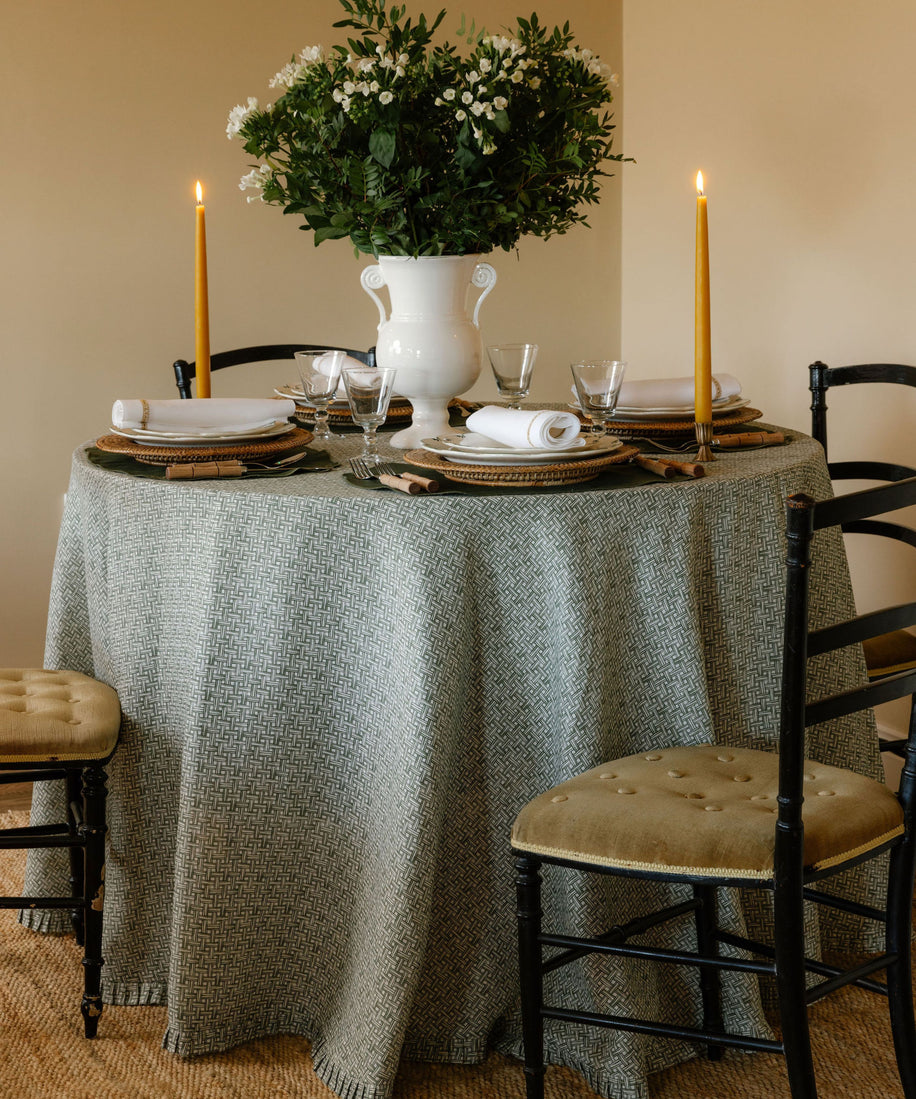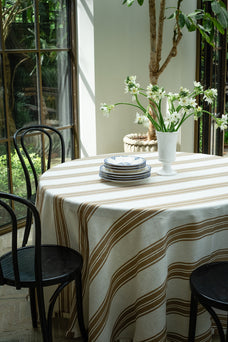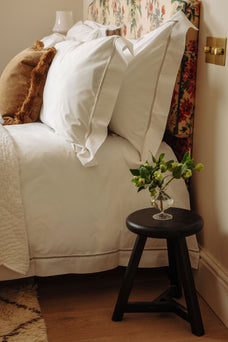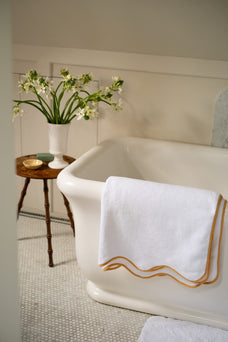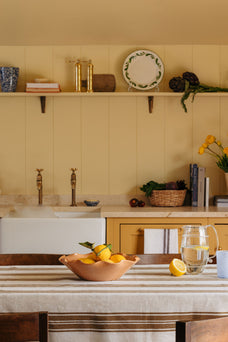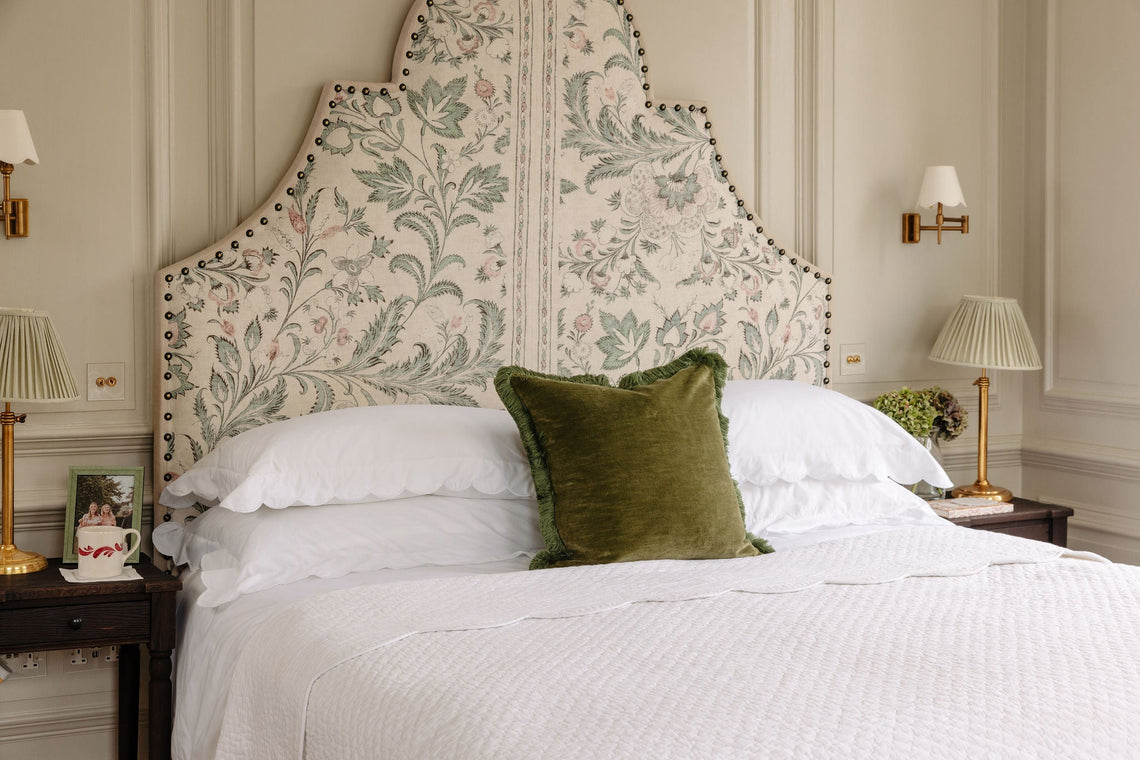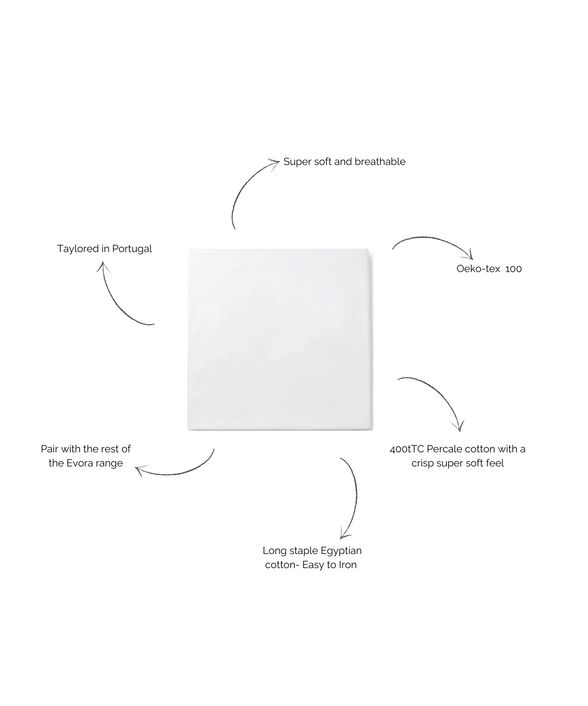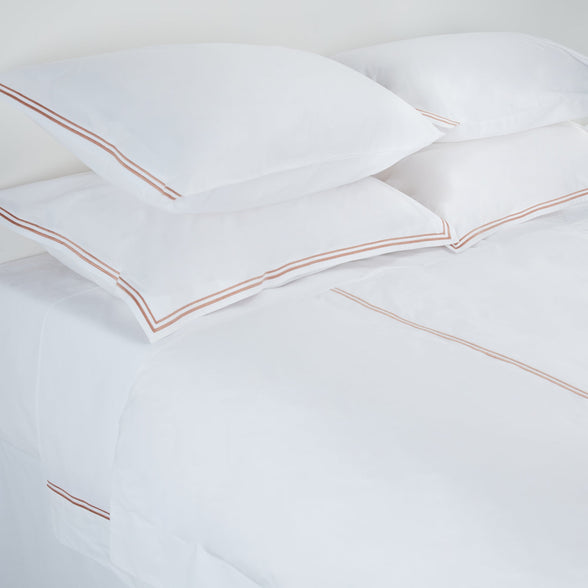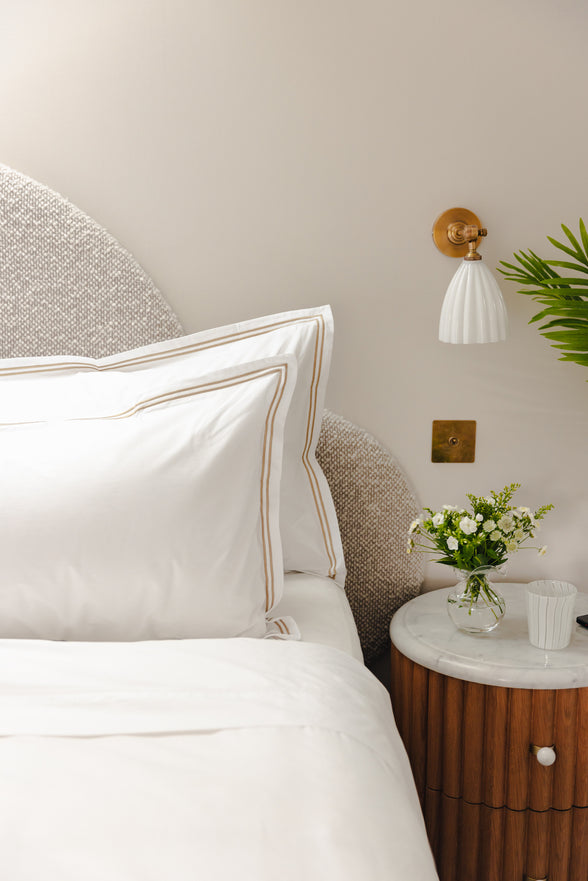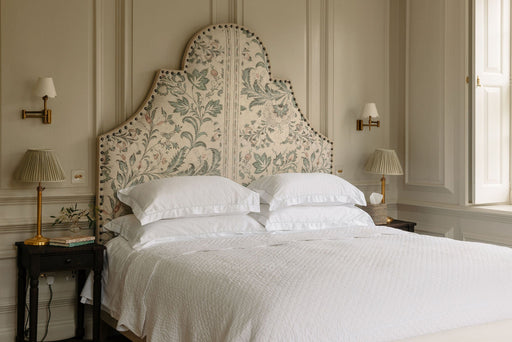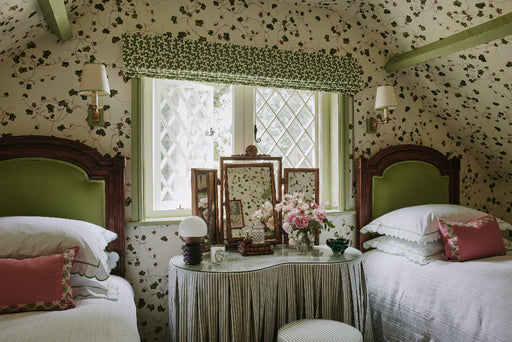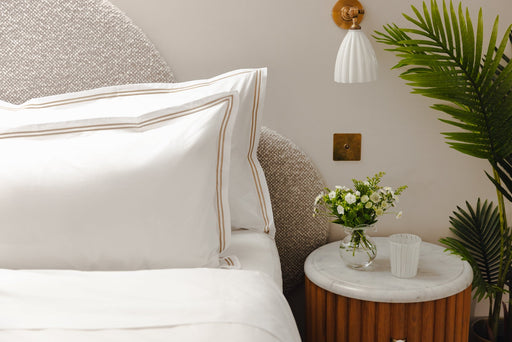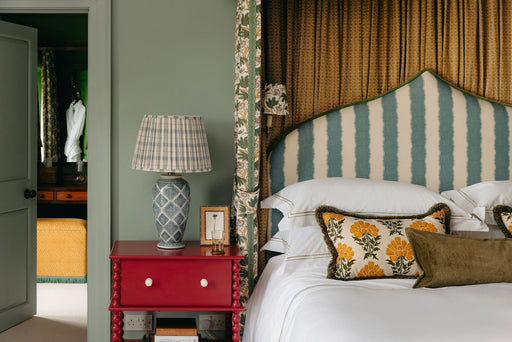Exceptional quality bed linen is worth its investment, multiple times over. Long outlasting lesser quality counterparts, high quality bed linen not only has greater longevity but it is softer, easier to iron, looks better, is more breathable and most of all - enables you to sleep better. Much better.
What fabric?
Our go-to fabric is cotton, as it perfectly balances breathability, longevity, softness and comfort as well as getting softer with each wash and being easier to care for. It is also very well suited to the majority of climates.
How do you like your cotton bed linen to feel?
Cotton can be woven with different weaves, altering the feel of the cotton. One major factor is that it alters how the cotton feels - such as crisp and cool or warm and silky. Other factors, such as durability and texture, can be changed.
Which weave of cotton - percale or sateen?
A percale weave is a closely woven plain weave fabric - one thread over, one thread under. It gives a matte, crisp finish and washes very well - the weave gives the yarns a lot of strength.
It feels crisp and cool to the skin and is best for warmer sleepers. It is the weave most commonly used in high-end hotels due to its long-lasting characteristics - it is less susceptible to pilling and gets softer with each wash.
Percale benefits
- Strong and durable
- Cool, crisp feel
- Resistant to pilling
- Gets softer with each wash
- Incredibly breathable
Sateen benefits
- Exceptionally soft and smooth from the outset
- Warmer to the touch - great for cooler climates
- Often has a gentle sheen
- Less prone to wrinkling
- Incredibly soft
Provenance
There are two factors to consider in regards provenance for cotton bed linen - the origin of the cotton fibres and where the fabric is weaved. Often, these are two different locations - there are masters at each.
Cotton fibres
The finest cotton fibres in the world are long, incredibly strong but fine and lustrous. The long fibres make the cotton stronger and smoother, among other benefits. One of the finest cotton varieties is Giza 87, for example, from Egypt. This is among the most rare cotton in the world, with a very low yield and exceptional demand - it commands exceptionally high prices. On request we can quote for Giza 87 bed linen from our Italian manufacturer - please contact us.
Giza 87 is an extreme in regards cotton quality, however this variety is exclusive to one very small area of Egypt specifically. Along with some other Egyptian cotton varieties, is what gives Egyptian cotton its reputation. However, bear in mind that not all cotton from Egypt is exceptional in quality, and that extra-long or long staple fibres can also be found elsewhere globally, such as America.
For exceptional bed linen, it's important that the quality of the cotton fibres are fantastic. Essentially, the weavers will maximise cotton's characteristics (a bit like cooking with high quality ingredients).
The environmental and climatic conditions in particular parts of the world, and their expertise developed over hundreds of years, has enabled these areas and to produce fine quality cotton.
Cotton weaving
The weaving and finishing capabilities of a mill optimise cotton's natural characteristics and improve its brightness, softness, longevity and breathability.
Cotton weaving also dates back centuries, and as a result, particular communities have developed considerable heritage know-how, passed down from generation to generation. Italy is renowned for weaving the very finest textiles globally, including cotton. Portugal also has exceptional cotton weaving capabilities.
To summarise, a combination of great cotton fibres and exceptional capabilities of the weaver result in beautifully soft, breathable and long lasting bed linen. A great chef with fine quality ingredients produces a delicious meal. Less so, if one of these factors is compromised.
What is thread count?
Thread count is simply the number of threads in a square inch. It is loosely related to the weight of the fabric - bear in mind that some cotton fibres are finer than others, so finer threads can mean a lightweight fabric at a higher thread count.
What thread count should I opt for?
Exceptional quality cotton should feel refined with a drape reminiscent of silk - not heavy, dense or thick.
High thread counts in bed linen have gained a reputation for "the best" due to an association with numbers - in many things, more is more. However, it is common practice in bed linen that high thread counts (600 or over) have artificially inflated thread counts. This is done by twisting individual cotton yarns together, sometimes two or three yarns, to "double" or "triple" the thread count (this is allowed). Ultimately, it makes the fabric less breathable, harder to iron, and usually means that lesser quality yarns have been used (it wouldn't be commercially viable to do this with high quality yarns), so the fabric is less soft with reduced longevity.
I am yet to find a thread count over 700 that is single ply, meaning it doesn't have twisted yarns. We can supply single ply bed linen up to 700 thread count.
A true 200 thread count cotton with long staple yarns will most certainly be higher quality than a 800 or 1000 thread count set, for example, as the latter is most likely woven with twisted yarns that are shorter (lesser quality). The 200 thread count cotton could also be more expensive, if the yarns are of fine quality and woven by a prestigious mill...
Thread count is somewhat baffling, and it can be very hard to really understand what you are buying and what "thread count" to opt for.
So, what quality measures should you focus on instead?
Rather than focusing on thread count, I recommend clients to opt for the best quality fibres they can afford. It's a little like a cashmere jumper over a woollen one - a lighter cashmere jumper is more luxurious than a heavy woollen one. For example, where budget allows, choosing 200 thread count, Italian woven, long staple cotton sheets will be softer, longer lasting, more breathable and less likely to wrinkle/easier to iron than 600 thread count, regular staple cotton sheets.
Another factor to consider in regards thread count is that percale sheets feel thicker at a lower thread count than sateen sheets. 220 thread count percale and 300 thread count sateen sheets are similar in weight - these weights are also the go-to for luxury hotels. Woven with the same quality yarns at the same mill, the 300 sateen is not automatically "better" than the 220 percale cotton.
Personally, I would never advocate 1000 thread count sheets as the yarns will be twisted, meaning the fabric is less breathable. It is likely that, unless commanding an exceptionally high price, the volume of cotton fibres required for 1000 thread count cotton means the quality of the cotton fibres have not been prioritised - it would be too costly.
If you take one thing away, quality over quantity, every time. My advice would be to prioritise single ply woven cotton first, then the quality of the weaver, followed by thread count.
We offer bed linen from Portugal and Italy. Both our ranges champion single ply, long or extra-long staple cotton that is made to last, get softer with each wash and is design-led.
Our Italian bed linen is all made to order, so you can choose the exact fabric, design, size and pieces to suit you and your bedroom. Our Portuguese range is stocked and available for immediate dispatch.
What specification of items are best for you?
Pillowcases
There are a various styles of pillowcases. The most common ones are; Oxford, housewife, large European square and boudoir. All of our pillowcases have a concealed flap enclosure for a high end finish that keeps the pillow neatly within the case.
An Oxford pillowcase has a border beyond the seam on four sides. This offers a decorative and luxurious finish.
A housewife pillowcase is a pillowcase without borders beyond the seam. Our housewife pillowcases have an Oxford border to the opposite side of the opening only (except our Cortona range, which has piping on the seams on four sides). This gives the most luxurious finish and allows for the design detail to feature.
For our custom range, it is possible for us to make pillowcases without a flange on any side, and where possible, have the design detail inset on the pillowcase. For example, on a corded design, the cording can be on the pillow itself and not on the seam, before a flange.
A large European square pillowcase is typically 65x65cm and usually with an Oxford border. This pillow is decorative, or used as a back rest when reading.
A boudoir pillowcase is typically 30x40cm and acts as a decorative pillow in the same style. Housewife style is possible, but usually this is an Oxford style.
Flat or fitted sheet?
For a bottom sheet, there is the option to have a flat or fitted sheet. A flat sheet is a hemmed, plain cotton sheet. This is neatly dressed on a bed with the corners neatly folded and tucked. A fitted sheet usually has elasticated corners.
What is best is largely personal preference. However, if you have a topper or particularly deep mattress, a flat sheet can be easier to ensure the best fit. A fitted sheet can be easier to make the bed, especially if it is difficult to get around all four sides of your bed.
Top sheet?
A top sheet sits underneath the duvet cover, above the bottom sheet. The top sheet is on top of you in the bed, with the bottom sheet on the mattress.
Top sheets are great in warmer climates, giving you cover without too much warmth. They can also be great in guest bedrooms, as the sheets and pillowcases can be washed and changed between guests without the need to fully change the bed.
Buttons or envelope flap enclosure?
Our custom range of bed linen has the option to choose either envelope or button enclosure. Which is best is personal preference, but here are some benefits.
Envelope enclosure
There is a flap at the bottom of the duvet, similar to a pillowcase enclosure, which the duvet sits in to. The flap then tucks underneath the mattress.
+ Faster to dress and undress the bed
+ A great option if you tuck your bed linen in to the side of your bed
+ More environmentally friendly (no buttons)
+ Keeps the duvet cover more in place whilst sleeping, if there is a tendency for the duvet to be turned in the night
- If you move and pull a lot when you sleep, the flap can come loose from underneath the duvet during the night
- If you prefer to pull a duvet up and around you, the possibility to do this is lessened as the duvet is secured to the bottom of the bed
Buttons enclosure
For our duvets, our button enclosures are concealed with a flap (meaning they are not visible when the bed is made).
+ You have full movement of the duvet, without the bottom being secured under the mattress
+ More familiar, if you are not used to envelope flap
+ The bed can need less tidying in the morning
- Can take more time to make and undress the bed
- Not best suited if you prefer to tuck your duvet in to the sides of your bed, as the buttons can get caught and damaged
Still need help?
We can assist and help you prioritise your bed linen budget, balancing design and fabric. For example, a hand applied, fabric trim scalloped bed linen set is much more of an investment than a classic Oxford set, in the same fabric. It is helpful to understand your priorities, and what you like and dislike about your current bed linen.
Please contact us.
Shop our custom Italian bed linen range
Shop our stocked, Portuguese bed linen range
Shop our bed linens with our size guide & our bespoke bed linens with this guide

